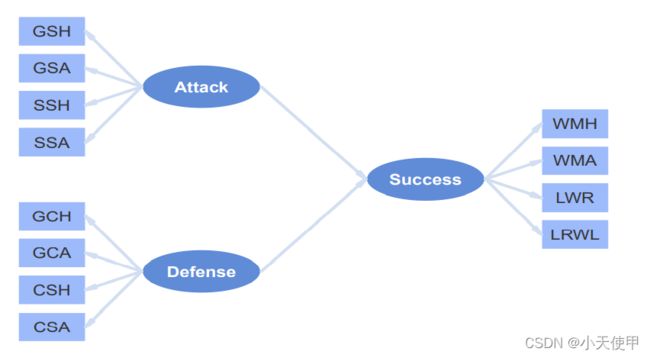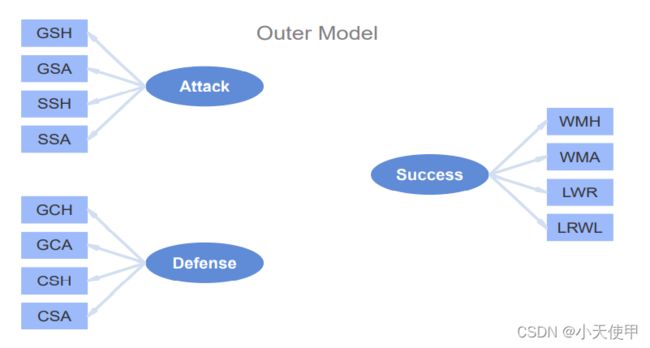- R 语言中的判断语句
lsx202406
开发语言
R语言中的判断语句在R语言编程中,判断语句是执行条件逻辑的基础。它们允许程序根据特定的条件执行不同的代码块。本文将深入探讨R语言中的几种常见判断语句,包括if语句、if-else语句和switch语句,并探讨它们的用法和场景。1.if语句if语句是R语言中最基本的条件判断结构。它的基本形式如下:if(条件){#条件为真时执行的代码块}当条件为真时,R会执行大括号内的代码块。如果条件为假,则不会执行
- 从0开始学习R语言--Day31--概率图模型
Chef_Chen
学习
在探究变量之间的相关性时,由于并不是每次分析数据时所用的样本集都能囊括所有的情况,所以单纯从样本集去下判断会有武断的嫌疑;同样的,我们有时候也想要在数据样本不够全面时就能对结果有个大概的了解。例如医生在给患者做诊断时,有些检查需要耗费的时间很久,但仅仅凭借一些其他的症状,他就可以对病人患某种病有个大概的猜想,从而先做出一些措施来降低风险,毕竟等到疾病真正发生时可能会来不及。概率图模型便是能够同时进
- Jmeter使用过程中的一些总结
kanyun123
jmeter
以下总结使用的Jmeter版本为5.6.31、当把Jmeter语言转换为中文时,可能会出现jmeter日志不出现,当发现Jmeter不发送请求时,不显示日志,排查问题就会没有头绪,此时可以尝试将语言切换为英文,再尝试发现日志出现了。2、当你辛辛苦苦地的做完的稳定性测试,还没来得及截图,这个时候,你心血来潮想切换下语言,然后你面发现测好的数据都没了。3、有些数据使用csv或者jmeter的内置函数都
- 分类树/装袋法/随机森林算法的R语言实现
廖致君
R
原文首发于简书于[2018.06.12]本文是我自己动手用R语言写的实现分类树的代码,以及在此基础上写的袋装法(bagging)和随机森林(randomforest)的算法实现。全文的结构是:分类树基本知识predginisplitrulesplitrule_bestsplitrule_randomsplittingbuildTreepredict装袋法与随机森林基本知识baggingpredic
- flutter内容学习总结
玖柒凯哲
学习
Flutter语言学习引言随着移动互联网的快速发展,移动应用开发已成为软件开发领域的一个重要分支。为了满足日益增长的应用需求,开发者们寻求更高效、更便捷的开发工具。Flutter作为一个由Google推出的开源移动应用开发框架,它以其高效的编码体验、优秀的性能和可观的UI保真度吸引了众多开发者的关注。本学习内容总结报告将围绕Flutter开发环境的搭建、调试方法、核心组件和布局管理进行详细阐述。F
- 从0开始学习R语言--Day27--空间自相关
Chef_Chen
学习
有的时候,我们在数据进行分组时,会发现用正常的聚类分析的方法和思维,分组的情况不是很理想。其实这是因为我们常常会忽略一个问题:假设我们正在分析的数据是真实的,那么它也肯定在一定程度上符合客观规律。而如果我们正在分析的数据中,有真实的客观空间数据时,可以考虑用空间自相关的方法去分析。例如我们在分析城市犯罪率的时候,用聚类分析的思维,我们可能会思考不同城市的犯罪特征是什么,是否有相似点,亦或是试图把城
- 第100+42步 ChatGPT学习:R语言实现阈值调整
Jet4505
《100+XStepstoGetML》学习r语言开发语言chatgpt
今天来说个机器学习分类的概念,阈值。一、何为阈值这个阈值(Threshold)在二分类问题中起到了关键作用,它决定了模型预测结果的分类边界。在二分类问题中,模型通常会输出一个概率值(介于0和1之间),表示样本属于某一类(通常为正类)的可能性。阈值的作用是将这个概率值转换为具体的分类结果(0或1)。如果预测概率**大于阈值**,则分类为正类(1)。如果预测概率**小于或等于阈值**,则分类为负类(0
- 从0开始学习R语言--Day26--因果推断
很多时候我们在探讨数据的相关性问题时,很容易会忽略到底是数据本身的特点还是真的是因为特征的区分导致的不同,从而误以为是特征起的效果比较大。这就好比测试一款新药是否真的能治病,假如吃药的患者康复的更快,那到底是因为药物本身的效果好,还是因为患者本身更健康,平时有控制饮食合理作息与运动,从而在患病后更快地凭借自身免疫力战胜病毒。这需要我们意识到对照试验还需要人为地补足某些条件,也就是探讨是否真的是X导
- 最新期刊影响因子,基本包含全部期刊
Bioinfo科研生信筆記
影响因子2024年期刊影响因子期刊因子因子IF
原文链接:2024年期刊最新影响因子(IF)2024年期刊最新影响因子(IF)BioinfoR生信筆記,注于分享生物信息学相关知识和R语言绘图教程。
- R语言文本探索与预处理:入门指南
Morpheon
Rr语言开发语言
今天是个阴雨连绵的夏日,因此带来今天的第二篇推文。祝您阅读愉快!文本探索和预处理是将非结构化文本转换为结构化数据进行分析的关键步骤。R语言中的正则表达式(Regex)正则表达式(Regex)是定义文本模式的字符序列,用于搜索、模式匹配和文本替换等任务。在处理搜索引擎和垃圾邮件过滤等应用中的非结构化文本时至关重要。R中常用的正则表达式函数:grep()/grepl():定位匹配模式的字符串;grep
- 文本聚类分析:基于相似性的文档分组
Morpheon
RRTextClustering
大家周一快乐!最近世界局势动荡,中东冲突不断。这种混乱可能会影响我们对世界的认知。就像法国人说的“C’estlavie”(这就是生活)。但无论未来如何,请记住瑞士人常说的“Lavieestbelle”(生活是美好的)。文本聚类分析通过内容相似性将文档分组,实现在R语言中自动对大型文本集合进行分类。什么是文本聚类分析?聚类分析将文档分组,使得同一组内的文档彼此之间的相似度高于与其他组中文档的相似度。
- scanpy读取10x单细胞数据
木与长清
单细胞数据处理python
做单细胞或空间组课题时经常会需要导入文献中的单细胞数据作为参考,市面上最常见的格式又以10xgenomics为主要代表,通常包括barcodes.tsv.gz、features.tsv.gz(或者genes.tsv.gz)、matrix.mtx.gz三种格式文件。在面对数据读取问题时,R语言Seurat包有Read10X函数,Python中scanpy包则对应scanpy.read_10x_mtx
- Flutter 与原生技术(Objective-C/Swift,java)的关系
BAGAE
cocoamacosobjective-c智慧城市java开发语言hbase
在iOS开发中,Flutter与原生技术(Objective-C/Swift)的关系一、技术定位与核心差异Flutter语言:使用Dart语言开发,通过AOT(提前编译)将代码转换为原生ARM指令,无需依赖iOS原生UI组件。渲染:使用Skia图形引擎直接渲染UI,实现跨平台UI一致性。优势:一套代码同时支持iOS和Android,开发效率高;UI表现可控性强。iOS原生开发语言:主流语言为Swi
- R语言非结构化文本挖掘入门指南
Morpheon
Rr语言开发语言
文本挖掘(TextMining),也称为文本分析(TextAnalytics),是从非结构化文本数据中提取有意义的见解。全球约80%的数据是非结构化的。本篇博客将探讨文本挖掘和网络爬取的关键概念及基于R的实用技术。什么是文本挖掘?文本挖掘利用计算技术从非结构化文本源(如书籍、报告、文章、博客和社交媒体帖子)中提取结构化信息。它能够自动化地从海量数据集中发现知识,实现文本摘要和分析。关键点:非结构化
- 从0开始学习R语言--Day20-ARIMA与格兰杰因果检验
Chef_Chen
学习r语言开发语言
ARIMAARIMA模型的核心就藏在其名字里,AR(自回归)代表了要预测的数据可能跟历史数据有关系,I(差分)代表了历史数据点之间的差异,MA(移动平均)代表了在预测历史数据点产生的误差可以在预测未来数据时修正,这三个点加起来共同用历史数据来预测未来值。举个浅显的例子就是,假设要预测明天会不会下雨,首先我们查看过去的数据带你,如果过去连续三天都下雨,那么明天下雨的概率就会很高,对应着AR,即用过去
- Anaconda 基础教程
一、什么是Anaconda?Anaconda是一个开源的Python和R语言的发行版本,致力于为数据科学、机器学习、大数据处理和科学计算提供便利的包管理和环境管理工具。它包含了conda包管理器和超过1500个数据科学常用的库。二、Anaconda的核心组成Conda:用于包管理和环境管理的工具。AnacondaNavigator:图形界面的包和环境管理工具。预装库:如NumPy、Pandas、M
- R语言序列8——RMarkdown与数据报告自动化
theskylife
R语言的修炼之路r语言自动化开发语言
目录写在开头1.RMarkdown基础1.1开始第一个RMarkdown1.1.1安装R和RStudio1.1.2.安装pandoc1.1.3.创建一个新的RMarkdown文档1.1.4.编辑RMarkdown文档1.1.5.渲染文档1.1.6.导出文档1.2文档结构与语法1.3不同输出格式的配置(HTML、PDF、Word)2.动态报告与参数化报告2.1插入R代码和结果2.2使用参数化报告定制
- 【科研绘图系列】R语言绘制论文组图(multiple plots)
生信学习者1
SCI科研绘图系列r语言数据分析数据挖掘数据可视化
禁止商业或二改转载,仅供自学使用,侵权必究,如需截取部分内容请后台联系作者!文章目录介绍加载R包数据下载导入数据数据预处理画图1画图2画图3画图4输出图片总结系统信息介绍一个用于分析和可视化博茨瓦纳婴儿微生物组研究(BotswanaInfantMicrobiomeStudy)中呼吸道病毒和细菌数据的R脚本。代码的主要目的是生成论文中的Figure1,包括三个子图(a、b、c),并保存相关的数据和图
- 从0开始学习R语言--Day20--Wilcoxon秩和检验
Chef_Chen
学习r语言开发语言
Wilcoxon秩和检验当数据不满足正态分布时,我们常常会苦恼于如何处理数据。即使是用缩进的方法,把数据缩进到(1-99%)或(1-95%)的范围内,假如有一些数据点集中在数据分布的尾端,这依然会影响到我们对数据特点的判断,尤其是需要探寻数据组之间的联系或关系的时候。而实际上,假设我们要探究的不是数据在统计上的数值关系,而是因果关系或比较,我们可以把数据处理成秩次的形式,从而去对比数据组,这样相当
- 从0开始学习R语言--Day19--连续变量的相关性检验
Chef_Chen
学习r语言开发语言
昨天我们学习了分类变量的检验方法,今天我们来看看连续性变量的相关性检验方法。Pearson一般来说,person适用于两个变量之间满足线性的单调关系,像我们常说的单调递增或单调递减,且我们的变量是连续且正态分布的。简单来说,就是变量拥有无限的可能性,比如身高可能是160.1,160.9,185.32等等,且大部分的值都在平均值附近(比如一个城市成年男性的平均身高)。听起来似乎很简单,但有时候可以有
- 从0开始学习R语言--Day21--Kruskal-Wallis检验与Friedman检验
Chef_Chen
学习
Kruskal-Wallis检验Kruskal-Wallis检验一般用于比较常见的比较三个群体的水平,比如我们有一班、二班、三班的语文成绩,我们将三个班的学生成绩混合在一起进行排名,也就是我们平时所说的级排名。进一步通过计算班级的平均级排名来判断班级之间的班级水平,这个方法要求数据之间要独立分布,即不要有类似三个班之间会有互相辅导的情况,不互相影响。Friedman检验Friedman检验同样用于
- 300+SCI科研绘图系列教程(R和python)提供完整的数据和代码
生信学习者1
SCI科研绘图系列r语言python数据可视化
科研绘图系列:科研绘图系列:R语言分组柱状图三科研绘图系列:箱线图加百分比点图展示组间差异-CSDN博客科研绘图系列:箱线图加蜜蜂图展示组间数据分布-CSDN博客科研绘图系列:小提琴图和双侧小提琴图展示组间差异-CSDN博客科研绘图系列:组间差异的STAMP图的ggplot2实现-CSDN博客科研绘图系列:组间差异误差棒展示-CSDN博客科研绘图系列:甜圈圈donut图展示比例-CSDN博客科研绘
- 【科研绘图系列】R语言绘制论文组图(multiple plots)
生信学习者1
SCI科研绘图系列r语言数据分析数据挖掘数据可视化
禁止商业或二改转载,仅供自学使用,侵权必究,如需截取部分内容请后台联系作者!文章目录介绍加载R包数据下载导入数据数据预处理画图1画图2画图3画图4画图5画图6输出图片总结系统信息介绍这段代码是用于分析和可视化博茨瓦纳婴儿微生物组研究(BotswanaInfantMicrobiomeStudy)中呼吸道病毒和细菌定植数据的R脚本。代码的主要目的是生成论文中的Figure3,包括五个子图(a、b、c、
- 【R语言编程——数据调用】
南瓜胖胖
r语言开发语言
这里写自定义目录标题可用库及数据集外部数据导入方法查看数据集信息在R语言中,有多个库支持调用内置数据集或外部数据,包括studentdata等教学或示例数据集。以下是常见的库和方法:可用库及数据集openintro库该库包含多个教学数据集,包括studentdata。安装并加载库后可直接调用:install.packages("openintro")library(openintro)data(s
- go语言 第三方包安装方法_GO富集分析可视化:R语言GOplot包
找R语言做弦图的教程的时候发现了这个包:GOplot。其主要功能是可视化GO富集分析的结果。自己应该会用得到。第一步是学习其帮助文档中的例子,然后学习如何准备自己的数据,并利用这个包中的函数来绘图查看帮助文档library(GOplot)help(package="GOplot")重复帮助文档中的教程data(EC)class(EC)dim(EC$david)dim(EC$genelist)cir
- 实验设计与分析(第6版,Montgomery著,傅珏生译) 第10章拟合回归模型10.9节思考题10.6 R语言解题
lishaoan77
实验设计与分析思考题回归r语言实验设计与数据分析‘线性回归回归显著性
本文是实验设计与分析(第6版,Montgomery著,傅珏生译)第10章拟合回归模型10.9节思考题10.6R语言解题。主要涉及线性回归、回归的显著性。10-6vialsummary(lm.fit)Call:lm.default(formula=Viscosity~Temperature+Catalyst,data=visc)Residuals:123456-24.98724.30711.820-
- 实验设计与分析(第6版,Montgomery著,傅珏生译) 第10章拟合回归模型10.9节思考题10.12 R语言解题
lishaoan77
实验设计与分析思考题回归r语言实验设计与数据分析线性回归回归显著性残差分析
本文是实验设计与分析(第6版,Montgomery著,傅珏生译)第10章拟合回归模型10.9节思考题10.12R语言解题。主要涉及线性回归、回归的显著性、残差分析。10-12vialsummary(lm.fit)Call:lm.default(formula=Viscosity~(Temperature)^2+(Catalyst)^2,data=visc)Residuals:Min1QMedian
- R语言入门-学习笔记记录
小狗狗跑数据
r语言
###第1章:基础入门##第1章-3.R扩展包的10个问题#安装某个扩展包#也可以在右下角的框中“packages”栏中的“install”项目中操作install.packages("devtools")#查看已安装的扩展包#也可以在右下角的框中“packages”栏中查看installed.packages()#更新:第一行查看未更新的扩展包;第二行执行更新指令。#也可以在右下角的框中“pac
- 【R语言编程绘图-mlbench】
南瓜胖胖
r语言开发语言机器学习
mlbench库简介mlbench是一个用于机器学习的R语言扩展包,主要用于提供经典的基准数据集和工具,常用于算法测试、教学演示或研究场景。该库包含多个知名数据集,涵盖分类、回归、聚类等任务。包含的主要数据集BostonHousing波士顿房价数据集,包含506条记录和14个特征,用于回归任务。目标变量为房屋中位数价格。BreastCancer威斯康星州乳腺癌数据集(原始版),包含699个样本和1
- R语言错误处理方法大全
weixin_49320263
常用方法r语言开发语言
在R语言的批量运行中,常需要自动跳过错误,继续向下运行。1、使用tryCatch()捕获错误并返回占位符#示例:循环中跳过错误继续执行results<-numeric(5)#预分配结果向量for(iin1:5){#用tryCatch包裹可能出错的代码results[i]<-tryCatch({if(i==3)stop("故意制造的错误")#模拟错误log(i-1)#正常计算},error=func
- 设计模式介绍
tntxia
设计模式
设计模式来源于土木工程师 克里斯托弗 亚历山大(http://en.wikipedia.org/wiki/Christopher_Alexander)的早期作品。他经常发表一些作品,内容是总结他在解决设计问题方面的经验,以及这些知识与城市和建筑模式之间有何关联。有一天,亚历山大突然发现,重复使用这些模式可以让某些设计构造取得我们期望的最佳效果。
亚历山大与萨拉-石川佳纯和穆雷 西乐弗斯坦合作
- android高级组件使用(一)
百合不是茶
androidRatingBarSpinner
1、自动完成文本框(AutoCompleteTextView)
AutoCompleteTextView从EditText派生出来,实际上也是一个文本编辑框,但它比普通编辑框多一个功能:当用户输入一个字符后,自动完成文本框会显示一个下拉菜单,供用户从中选择,当用户选择某个菜单项之后,AutoCompleteTextView按用户选择自动填写该文本框。
使用AutoCompleteTex
- [网络与通讯]路由器市场大有潜力可挖掘
comsci
网络
如果国内的电子厂商和计算机设备厂商觉得手机市场已经有点饱和了,那么可以考虑一下交换机和路由器市场的进入问题.....
这方面的技术和知识,目前处在一个开放型的状态,有利于各类小型电子企业进入
&nbs
- 自写简单Redis内存统计shell
商人shang
Linux shell统计Redis内存
#!/bin/bash
address="192.168.150.128:6666,192.168.150.128:6666"
hosts=(${address//,/ })
sfile="staticts.log"
for hostitem in ${hosts[@]}
do
ipport=(${hostitem
- 单例模式(饿汉 vs懒汉)
oloz
单例模式
package 单例模式;
/*
* 应用场景:保证在整个应用之中某个对象的实例只有一个
* 单例模式种的《 懒汉模式》
* */
public class Singleton {
//01 将构造方法私有化,外界就无法用new Singleton()的方式获得实例
private Singleton(){};
//02 申明类得唯一实例
priva
- springMvc json支持
杨白白
json springmvc
1.Spring mvc处理json需要使用jackson的类库,因此需要先引入jackson包
2在spring mvc中解析输入为json格式的数据:使用@RequestBody来设置输入
@RequestMapping("helloJson")
public @ResponseBody
JsonTest helloJson() {
- android播放,掃描添加本地音頻文件
小桔子
最近幾乎沒有什麽事情,繼續鼓搗我的小東西。想在項目中加入一個簡易的音樂播放器功能,就像華為p6桌面上那麼大小的音樂播放器。用過天天動聽或者QQ音樂播放器的人都知道,可已通過本地掃描添加歌曲。不知道他們是怎麼實現的,我覺得應該掃描設備上的所有文件,過濾出音頻文件,每個文件實例化為一個實體,記錄文件名、路徑、歌手、類型、大小等信息。具體算法思想,
- oracle常用命令
aichenglong
oracledba常用命令
1 创建临时表空间
create temporary tablespace user_temp
tempfile 'D:\oracle\oradata\Oracle9i\user_temp.dbf'
size 50m
autoextend on
next 50m maxsize 20480m
extent management local
- 25个Eclipse插件
AILIKES
eclipse插件
提高代码质量的插件1. FindBugsFindBugs可以帮你找到Java代码中的bug,它使用Lesser GNU Public License的自由软件许可。2. CheckstyleCheckstyle插件可以集成到Eclipse IDE中去,能确保Java代码遵循标准代码样式。3. ECLemmaECLemma是一款拥有Eclipse Public License许可的免费工具,它提供了
- Spring MVC拦截器+注解方式实现防止表单重复提交
baalwolf
spring mvc
原理:在新建页面中Session保存token随机码,当保存时验证,通过后删除,当再次点击保存时由于服务器端的Session中已经不存在了,所有无法验证通过。
1.新建注解:
? 1 2 3 4 5 6 7 8 9 10 11 12 13 14 15 16 17 18
- 《Javascript高级程序设计(第3版)》闭包理解
bijian1013
JavaScript
“闭包是指有权访问另一个函数作用域中的变量的函数。”--《Javascript高级程序设计(第3版)》
看以下代码:
<script type="text/javascript">
function outer() {
var i = 10;
return f
- AngularJS Module类的方法
bijian1013
JavaScriptAngularJSModule
AngularJS中的Module类负责定义应用如何启动,它还可以通过声明的方式定义应用中的各个片段。我们来看看它是如何实现这些功能的。
一.Main方法在哪里
如果你是从Java或者Python编程语言转过来的,那么你可能很想知道AngularJS里面的main方法在哪里?这个把所
- [Maven学习笔记七]Maven插件和目标
bit1129
maven插件
插件(plugin)和目标(goal)
Maven,就其本质而言,是一个插件执行框架,Maven的每个目标的执行逻辑都是由插件来完成的,一个插件可以有1个或者几个目标,比如maven-compiler-plugin插件包含compile和testCompile,即maven-compiler-plugin提供了源代码编译和测试源代码编译的两个目标
使用插件和目标使得我们可以干预
- 【Hadoop八】Yarn的资源调度策略
bit1129
hadoop
1. Hadoop的三种调度策略
Hadoop提供了3中作业调用的策略,
FIFO Scheduler
Fair Scheduler
Capacity Scheduler
以上三种调度算法,在Hadoop MR1中就引入了,在Yarn中对它们进行了改进和完善.Fair和Capacity Scheduler用于多用户共享的资源调度
2. 多用户资源共享的调度
- Nginx使用Linux内存加速静态文件访问
ronin47
Nginx是一个非常出色的静态资源web服务器。如果你嫌它还不够快,可以把放在磁盘中的文件,映射到内存中,减少高并发下的磁盘IO。
先做几个假设。nginx.conf中所配置站点的路径是/home/wwwroot/res,站点所对应文件原始存储路径:/opt/web/res
shell脚本非常简单,思路就是拷贝资源文件到内存中,然后在把网站的静态文件链接指向到内存中即可。具体如下:
- 关于Unity3D中的Shader的知识
brotherlamp
unityunity资料unity教程unity视频unity自学
首先先解释下Unity3D的Shader,Unity里面的Shaders是使用一种叫ShaderLab的语言编写的,它同微软的FX文件或者NVIDIA的CgFX有些类似。传统意义上的vertex shader和pixel shader还是使用标准的Cg/HLSL 编程语言编写的。因此Unity文档里面的Shader,都是指用ShaderLab编写的代码,然后我们来看下Unity3D自带的60多个S
- CopyOnWriteArrayList vs ArrayList
bylijinnan
java
package com.ljn.base;
import java.util.ArrayList;
import java.util.Iterator;
import java.util.List;
import java.util.concurrent.CopyOnWriteArrayList;
/**
* 总述:
* 1.ArrayListi不是线程安全的,CopyO
- 内存中栈和堆的区别
chicony
内存
1、内存分配方面:
堆:一般由程序员分配释放, 若程序员不释放,程序结束时可能由OS回收 。注意它与数据结构中的堆是两回事,分配方式是类似于链表。可能用到的关键字如下:new、malloc、delete、free等等。
栈:由编译器(Compiler)自动分配释放,存放函数的参数值,局部变量的值等。其操作方式类似于数据结构中
- 回答一位网友对Scala的提问
chenchao051
scalamap
本来准备在私信里直接回复了,但是发现不太方便,就简要回答在这里。 问题 写道 对于scala的简洁十分佩服,但又觉得比较晦涩,例如一例,Map("a" -> List(11,111)).flatMap(_._2),可否说下最后那个函数做了什么,真正在开发的时候也会如此简洁?谢谢
先回答一点,在实际使用中,Scala毫无疑问就是这么简单。
- mysql 取每组前几条记录
daizj
mysql分组最大值最小值每组三条记录
一、对分组的记录取前N条记录:例如:取每组的前3条最大的记录 1.用子查询: SELECT * FROM tableName a WHERE 3> (SELECT COUNT(*) FROM tableName b WHERE b.id=a.id AND b.cnt>a. cnt) ORDER BY a.id,a.account DE
- HTTP深入浅出 http请求
dcj3sjt126com
http
HTTP(HyperText Transfer Protocol)是一套计算机通过网络进行通信的规则。计算机专家设计出HTTP,使HTTP客户(如Web浏览器)能够从HTTP服务器(Web服务器)请求信息和服务,HTTP目前协议的版本是1.1.HTTP是一种无状态的协议,无状态是指Web浏览器和Web服务器之间不需要建立持久的连接,这意味着当一个客户端向服务器端发出请求,然后We
- 判断MySQL记录是否存在方法比较
dcj3sjt126com
mysql
把数据写入到数据库的时,常常会碰到先要检测要插入的记录是否存在,然后决定是否要写入。
我这里总结了判断记录是否存在的常用方法:
sql语句: select count ( * ) from tablename;
然后读取count(*)的值判断记录是否存在。对于这种方法性能上有些浪费,我们只是想判断记录记录是否存在,没有必要全部都查出来。
- 对HTML XML的一点认识
e200702084
htmlxml
感谢http://www.w3school.com.cn提供的资料
HTML 文档中的每个成分都是一个节点。
节点
根据 DOM,HTML 文档中的每个成分都是一个节点。
DOM 是这样规定的:
整个文档是一个文档节点
每个 HTML 标签是一个元素节点
包含在 HTML 元素中的文本是文本节点
每一个 HTML 属性是一个属性节点
注释属于注释节点
Node 层次
- jquery分页插件
genaiwei
jqueryWeb前端分页插件
//jquery页码控件// 创建一个闭包 (function($) { // 插件的定义 $.fn.pageTool = function(options) { var totalPa
- Mybatis与Ibatis对照入门于学习
Josh_Persistence
mybatisibatis区别联系
一、为什么使用IBatis/Mybatis
对于从事 Java EE 的开发人员来说,iBatis 是一个再熟悉不过的持久层框架了,在 Hibernate、JPA 这样的一站式对象 / 关系映射(O/R Mapping)解决方案盛行之前,iBaits 基本是持久层框架的不二选择。即使在持久层框架层出不穷的今天,iBatis 凭借着易学易用、
- C中怎样合理决定使用那种整数类型?
秋风扫落叶
c数据类型
如果需要大数值(大于32767或小于32767), 使用long 型。 否则, 如果空间很重要 (如有大数组或很多结构), 使用 short 型。 除此之外, 就使用 int 型。 如果严格定义的溢出特征很重要而负值无关紧要, 或者你希望在操作二进制位和字节时避免符号扩展的问题, 请使用对应的无符号类型。 但是, 要注意在表达式中混用有符号和无符号值的情况。
&nbs
- maven问题
zhb8015
maven问题
问题1:
Eclipse 中 新建maven项目 无法添加src/main/java 问题
eclipse创建maevn web项目,在选择maven_archetype_web原型后,默认只有src/main/resources这个Source Floder。
按照maven目录结构,添加src/main/ja
- (二)androidpn-server tomcat版源码解析之--push消息处理
spjich
javaandrodipn推送
在 (一)androidpn-server tomcat版源码解析之--项目启动这篇中,已经描述了整个推送服务器的启动过程,并且把握到了消息的入口即XmppIoHandler这个类,今天我将继续往下分析下面的核心代码,主要分为3大块,链接创建,消息的发送,链接关闭。
先贴一段XmppIoHandler的部分代码
/**
* Invoked from an I/O proc
- 用js中的formData类型解决ajax提交表单时文件不能被serialize方法序列化的问题
中华好儿孙
JavaScriptAjaxWeb上传文件FormData
var formData = new FormData($("#inputFileForm")[0]);
$.ajax({
type:'post',
url:webRoot+"/electronicContractUrl/webapp/uploadfile",
data:formData,
async: false,
ca
- mybatis常用jdbcType数据类型
ysj5125094
mybatismapperjdbcType
MyBatis 通过包含的jdbcType
类型
BIT FLOAT CHAR


